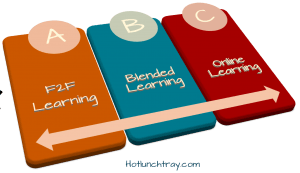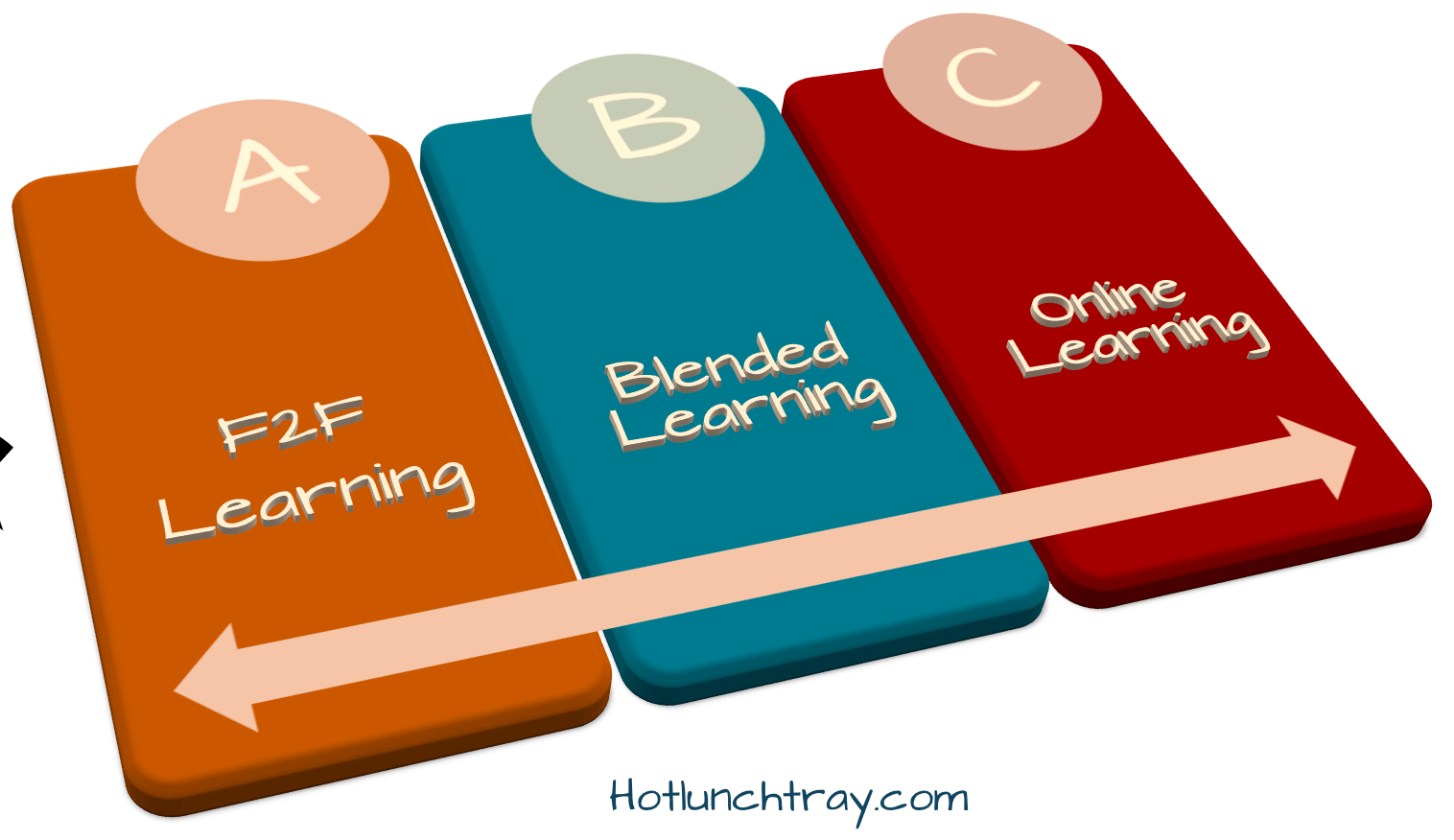Learn How?
Learn Where?

Learning Continuum
I recently had the opportunity to attend a virtual school summer professional learning conference. I am not an online teacher, so I was excited about learning more about online teaching and how it compared or contrasted to face-to-face teaching.
Two assumptions I had to deal with immediately?
- I didn’t think they could really know each other as colleagues, you know like the way people I know those I work with on my team. These people all “knew” each other quite well. I felt more awkward meeting some of the folks I knew from Twitter for the first time in person than these folks walking up to each other for the first time in the same place and picking up on ongoing conversations. Cool.
- I could imagine how they knew their students well – and this probably goes to the heart of many assumptions about online learning – I thought it was less personal because it wasn’t face-to-face. However, I saw folks with a lot of compassion for and knowledge of such wide varieties of circumstances I think I would shelf that thought as well. I always thought it mattered if a “good” teacher showed up each day to the schoolhouse. I just never thought the variable in that idea was how a teacher shows up.
Learning more about what I consider “the exact opposite way I taught” helped me have a better vision of what blended learning could be with/for me and my content.
Default Learning
It used to be a safe assumption that most traditional K12 students were learning in a face-to-face(F2F) environment, however, that is increasingly not the case.
In April 2006, Michigan became the
first state to require online learning for
high school graduation. Since that time
Alabama, Florida, Idaho, and Virginia
have added requirements. Georgia, New
Mexico, and West Virginia recommend
students experience online learning before
graduation, however, it is not required.
Changing Course: Ten Years of Tracking Online Learning (2013) relates to higher ed, but K12 might look to this as a future indicator.
Keeping Pace with K12 Online and Blended Learning (2013) comprehensive overview of the state of K12 online/blended programs.
Is K12 Blended Learning Disruptive? (May 2013) Michael Horn examines which “blended learning” scenarios are working within our current system – hybrids – and which are truly disruptors.
Learning Continuum Bookends explain Blended Learning
If the background knowledge you have about K12 learning is the traditional face-to-face model it is difficult to fully consider a blended learning model. The same is true for those who only know online learning. If you don’t understand the exact opposite of what you are doing how do you know when you’ve reached the middle ground?
The act of learning about online learning will help face-to-face teachers design a blended version of their course(s) and vice versa.
Oh, I already *do* Blended Learning…
That’s great to hear. How do you define blended learning? The Sloan Consortium in their 2007 publication Blending_In defines it as
…blended courses and programs, are defined as having between 30 percent and 79 percent of the course content delivered online…
so we could assume you have somewhere between 30% – 79% of your content available online. Is that a static 30-79% or are your students able to choose which items/lessons/modules/units to take online and which to take face-to-face?
You see where this is headed, right? “Doing blended learning” is not a one-and-done event.
How can we Distribute this Work?
Because “doing blended learning” is not an item to be checked off an End of Year summer checkout list like cleaning out lockers; you might consider a methodical approach, with a plan over time:
-
- Over a period of x years, which of your items/lessons/modules/units/assessments* are you willing to make available online?
- Could you be part of a team which works together to make common items/lessons/modules/units/assessments* into non-Googlable projects, applications or problems?
- Do you have a team which could work together to make common items/lessons/modules/units/assessments* available online?
- What are your non-negotiables? What are you as an instructor wanting to deliberately keep in the face-to-face portion of your course(s)? This is a thinker and you are in charge of it – decide before someone decides for you!
- Do you have a way for students to self-select which elements they take face-to-face or complete online?
If you think this sounds like I am asking you to design an online version of your course(s) and then identify select elements which are only available face-to-face; well, that is what I am suggesting. But let me explain, please! I do not think this task should fall squarely on the shoulders of teachers alone. In the past teachers who “did” blended learning did it on their own, and that meant in addition to the other responsibilities.
My proposal is that teams of teachers should make starter course for grade levels/subject areas; and that teachers should do this as a paid part of their day in lieu of other responsibilities. (And can we be real for a minute? Not in their room, or down the hall, because the counselor/secretary/mother WILL find that teacher, and that teacher WILL stop to help because, well, they are a teacher and they help.) Once teachers have this start material it needs to be vetted by whoever does that in your district/school. And once it is approved the technical resources need to be checked by instructional specialists. Once these courses are published there needs to be a 24/7 help system available to students, parents, and teachers. How is that for not squarely on the shoulders of the teachers?
So, let’s Intentionally Alter our Default Learning
Let us consider learning on the continuum. It does not serve us to stay in our default mode if there are other ways students can/want to learn. We, teachers, are (mostly) self-selected face-to-face learners who pick this career to serve others like us; could we branch out and serve students who are just a little bit different than we are? Couldn’t we look at it as increasing our value instead of thinking an online course will replace us?
Increasing your awareness of the continuum of learning is not just an altruistic pursuit for the good of the students. Just like the old-fashioned textbook review committee, some of us are quickly reminded we are better at critiquing content than creating it. However, what if you find you have an undeveloped skill for content creation?
I challenge you, face-to-face experts, to skip over studying blended learning and go to examining online learning instead. By doing this you better prepare yourself and understand options for blending, identify your non-negotiables for your personal classroom. You are informed of the time/effort when someone inevitably comes knocking at your door asking to turn what you do into a blended learning unit in your spare time – show them your x year plan!
*just do not put things like assessments into proprietary formats (read: LMS assessment tools) instead strive for ways which let you maintain your assessments as-is to lessen repetitive work or convert assessments to problems which are solved by students.






4 Pingbacks